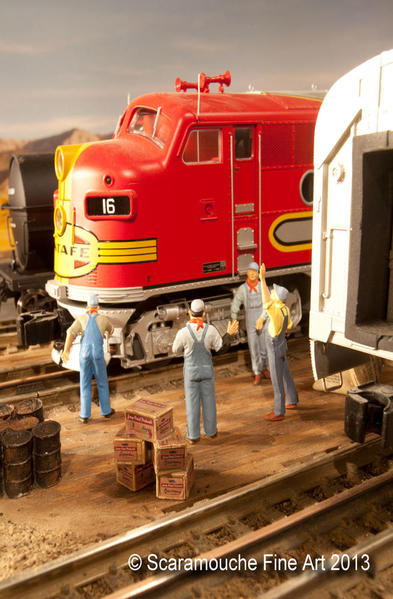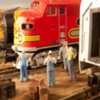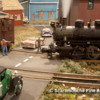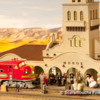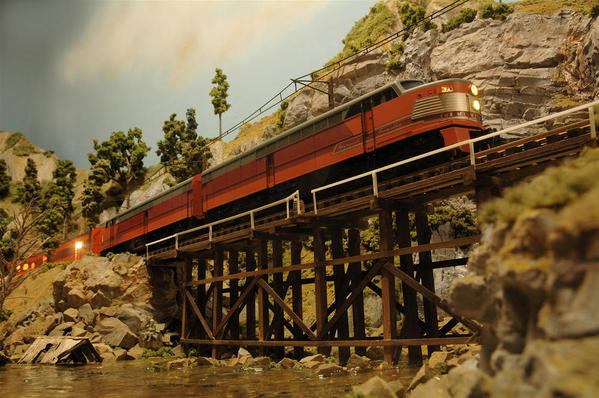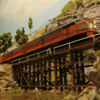I see a lot of MTH and Lionel on here. Just wondering how you folks feel about Atlas track,switches,and Loco's. Thanks
Replies sorted oldest to newest
I see a lot of MTH and Lionel on here. Just wondering how you folks feel about Atlas track,switches,and Loco's. Thanks
My whole layout is 100% Atlas O track & switches.
I think you'll find a lot of good comments here about Atlas products. The track is one of the best, their engines are finely detailed and run well. They use Lionel's TMCC and sound chips but still have a distinctive sound of their own.
Can't think of any negatives other than a few reported issues with some of their switches...
I like Atlas track and have it on one layout,but if I had a do over,I would use Ross switches with it. My second layout is K-Line Shadow rail and Ross tinplate switches.
Dale H
I don't use Atlas track and switches. I really like the way it looks, but I made a huge investment in Gargraves track and Ross switches long ago. Love their cars and engines, and have quite a few, though they can be a bit spendy.
I have a few pieces of atlas rolling stock, both trainman line and atlas O. My only critique is that the price for the atlas rolling stock is often higher than I feel like paying. I have no problem with quality or appearance.
the track is very attractive but out of my price range.
Hi
like the atlas track there switches need work.
you have to put better jumpers on them and change out the switch machines to under table mounts. Then the switches are good.
The engines are great like the fixed pilots on the diesels and the detail nice
what is meant by "better jumpers" on the switches ?? Thanks...I got to get my train lingo up to speed ..LOL
what is meant by "better jumpers" on the switches ?? Thanks...I got to get my train lingo up to speed ..LOL
Center rails are connected in three-rail switches via jumpers to maintain power across areas where the center rail doesn't run continuously in the switch. The earliest versions of Atlas-O turnouts employed thin wires embedded in the tie strips as jumpers. Unfortunately they were prone to breaking/melting often. Later (and current) versions of the turnouts used visible wires underneath the plastic ties connecting the center rails... But they could probably be a heavier gauge.
Ross uses heavy duty metal strips for these center rail jumpers on their turnouts, and the strips handle O-Gauge currents much better than the Atlas jumpers. For this reason, folks using Atlas turnouts often add their own jumpers beneath the turnouts to ensure long-lasting connections between the center rails.
David
Atlas, Weaver, RMT, Bachmann(Williams) are all here, just a little quieter than the big two.
I had their track and switches on my 3 rail layout and loved it, and I have several of their freights cars and a couple Geeps from them and I am happy with those as well.
The Atlas switches have been upgraded since I entered the hobby 11 years ago. There can be problems but there are corrections. It looks good, and is easy to maintain. Switch prices are comparable to Ross. Track price compared to Gargraves is quite a bit more.
Here are some pictures.

Note this center rail wiring connection, new Atlas switch. Poor connection at best, IMO. The plastic needs to be remove and the jumper screwed directly to the rail. There are usually (3) of these connection jumpers per Atlas switch.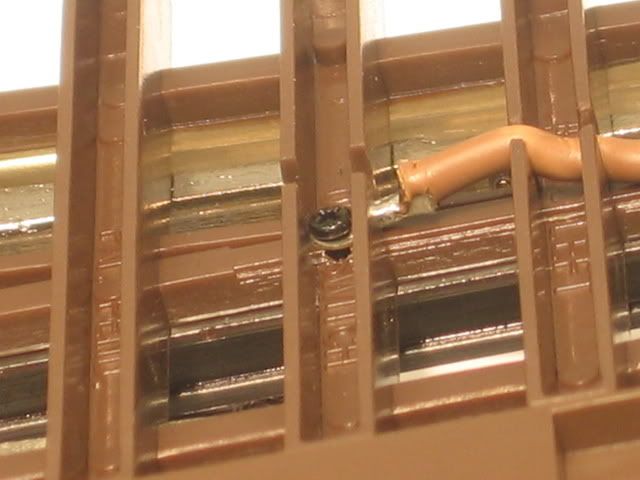
Also note that the Atlas rail joiners, early issue, had continuity problems and have been redesigned to be a much better connection. New Atlas track and switches should have rail joiners that are difficult to assemble, assuring a good electrical connection.
You can adapt Atlas track with their rail joiners to Gargraves or Ross. Note that the bottom of the Gargrave track needs to be removed with a Dremel or grinder.
Gargraves left/Atlas right.


I have three Atlas diesels with TMCC and railsounds.
They are the best locos I own.
I have several Atlas units. Atlas supplies undecorated units that can be custom painted.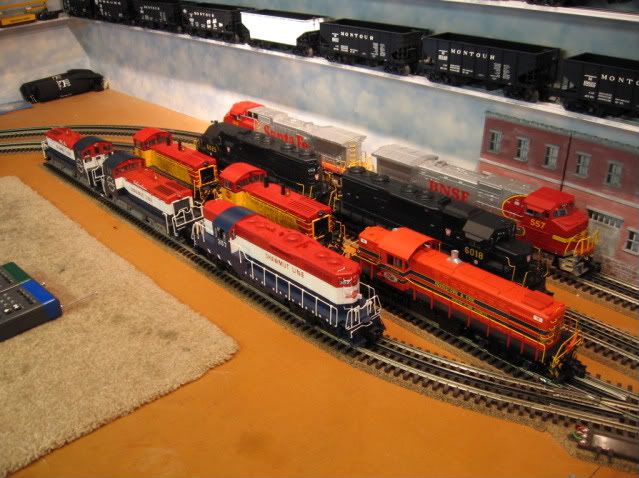
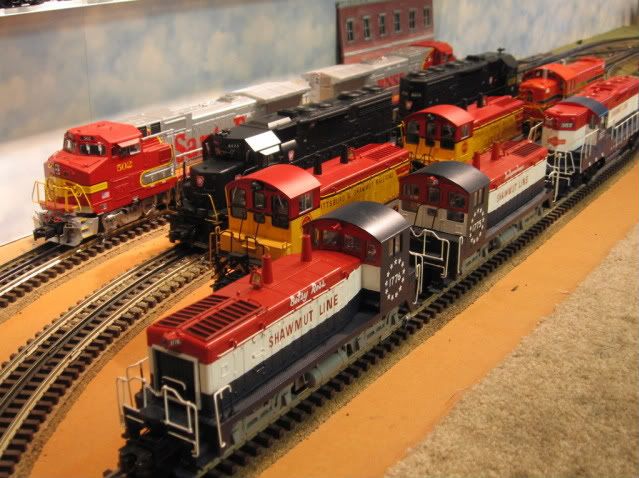
(4) additional SW9's, custom painted.
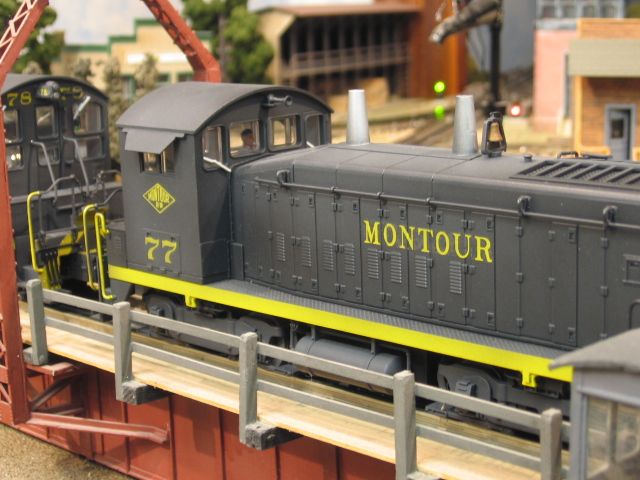

I really like their track and switches, and I would not change.
Their locos and rolling stock seem to end at the year 1985. I wish they made some more modern stuff. (Dash 8 is only exception I can think of, maybe the articulated auto racks.)
Entire layout Atlas O track and switches.
I have tried them all !!
Tested thoroughly before I decided all brands track and switches.
Why Atlas O switches? They are simply the best looking and match the track !
No contest whatsoever.
Scrappy
Attachments
At the local shows, the FCTT club has some great Atlas rolling stock and equipment to see running. It became my targeted level of detail for rolling stock that I was after.
I run with their track in two rail O gauge.
I have an Atlas RS-1 3 rail and a SW switcher 2 rail. Both are great locos. Smooth, great detail. As far as track, I like the look of Atlas track especially the solid rails but my current 3 rail layout is gargraves and Ross. If I ever do it over I think the Atlas track just looks better but would have to weigh the cost.
I really like their track and switches, and I would not change.
Their locos and rolling stock seem to end at the year 1985. I wish they made some more modern stuff. (Dash 8 is only exception I can think of, maybe the articulated auto racks.)
Actually there comes to mind a few other post-1985 prototype models that Atlas O came out with.
Trinity 25,500 gallon tank cars & 5151 covered hoppers (prototypes first built in 1986 and 1995 respectively).
The Trinity 17,600 gallon tank car was first built in 1984 but they were made up to 1998.
The GP60 was first built in 1985 but production continued up to 1994.
You're correct regarding the timeline your first two examples; the prototype Dash 8 made its debut in 1987 while the Thrall articulated auto carriers debuted ten years later.
Atlas and ScaleTrax are pretty well tied for first place in the appearance department - Atlas has the better tie spacing but the rails (all three) are oversized and tall compared to ScaleTrax with the lower profile and thin center blade. Notice how it doesn't overpower the F3 below and actually enhances the massiveness of the train.
It's really a matter of personal preference here. Both are excellent choices.
Gargraves/Ross high-rail track is too far out of scale for many of us as the ties also are way too large.
We have but one Atlas diesel and its a favorite, The handsome and highly detailed F2/3 Phase 2 in GM&O pictured here on ScaleTrax is a beautiful, smooth running, nice-sounding engine. These come with an extra fixed scale pilot and coupler that greatly enhances the appearance.
Here we left the stock pilot/coupler on the trailing unit to connect with regular cars. The fixed pilot eliminates this gap.
Attachments
Entire layout Atlas O track and switches.
I have tried them all !!
Tested thoroughly before I decided all brands track and switches.
Why Atlas O switches? They are simply the best looking and match the track !
No contest whatsoever.
Scrappy
I agree with Scrappy, my favorite also, but I haven't tried anything but FasTrak, RealTrax & Atlas. Like the solid nickel-silver rails & the looks too. Personally, I think it is great track and Atlas has some other great products as well.
Had a temporary layout last year with Atlas track just on bare plywood (no roadbed) and it was very quiet! Just moved a couple months ago and I will soon be making a more permanent layout with Atlas track & switches, will have roadbed this time. I like to fiddle with train stuff, so if the switches need a little fiddling it will give me an opportunity to learn more about them.
Will also be using the Atlas signal system, I think it is very nice and well thought out system. Really has a lot of nice features.
I have also emailed Atlas with a couple questions and got extremely fast and complete replies from them. Very thorough - Impressive! Good company!
No Atlas engines or rolling stock yet, will have some someday. So far MTH has been putting more in their catalogs (that I just have to have) than I can afford. Lionel has managed to get me for 1 diesel and a legacy system, which I am still waiting on from my LHS. (Lionel diesel was my favorite road name & color and LHS owner had it dangling right in front of me when I went in there a couple of months ago, I couldn't help it. It was all his fault!)
I've been slowly building my permanent layout for 2 years now with Atlas track. I think it looks great and to this point, there have been no electrical issues.
I currently have four O-72 switches and have had no issues with them either.
That is a beautiful shot and one reason ScaleTrax stays on my list. I'm really having a hard time deciding which track to use and am probably way over-thinking it. At the end of the day, is it really going to make that much difference?
To be honest, I'd like everything to look the same, but I hear so much about Ross and no one can deny that they definitely have the most options when it comes to switches. Guess I need to run over to Scottsdale again and take a closer look at how their Ross switches mate with their Atlas track. I will say the price difference is considerable. TK Train and Hobby lists them for:
Atlas 40" $14.37
ScaleTrax 30" $11.19
GarGraves 37.5" $6.54
Note: $14.40 to ship 3 pieces to Phoenix.
I see now why GarGraves is so popular. Given the size difference, Atlas and ScaleTrax are about even. Atlas has a slight edge, but both are twice the cost of GarGraves, really? The problem with ScaleTrax is the limited curve sizes and switches.
We use Atlas track with Rossbed on club modular layout. It is a very solid and realistic track system. Never have to worry about it rusting!
Gilly
Some really good information here as I have also wondered about Atlas locos.
My track and switches are all Atlas. The sound of trains and rolling stock going over Atlas on cork is music to my ears.
I have three switch machines that work nicely but required a lot of monkeying with to get there. All switch machines after that are Z Stuff. Smaller footprint and much more reliable.
I also love the way the little uncoupling section works but learned the hard way what to do and not to do with those.
If you decide to go with Atlas track you can readily acquire a ton of good advice on how to proceed from the members of this forum. ![]()
S
I really enjoy our Atlas locomotives ... and the great customer service by Atlas!
About 8 years ago I was asking about track and switches also. The answer I went with was Gargraves track and Ross switches. The answer at that time was that Gragraves switches and Atles had issues. Gragraves was the most cost effective track at the time. Looks like people in more recent times have had different results with the Atlas gear.
I have some Atlas rolling stock which has performed well.
Trinity 25,500 gallon tank cars & 5151 covered hoppers (prototypes first built in 1986 and 1995 respectively).
The Trinity 17,600 gallon tank car was first built in 1984 but they were made up to 1998.
The GP60 was first built in 1985 but production continued up to 1994.
You're correct regarding the timeline your first two examples; the prototype Dash 8 made its debut in 1987 while the Thrall articulated auto carriers debuted ten years later.
... I also love the way the little uncoupling section works but learned the hard way what to do and not to do with those...
Could you elaborate on this statement please? Like what it is you learned.
... I also love the way the little uncoupling section works but learned the hard way what to do and not to do with those...
Could you elaborate on this statement please? Like what it is you learned.
I have a small layout so I do switching and coupling/uncoupling to make things more interesting. My first endeavors were disastrous though. I have 4 dead uncouplers to show for it.
Primary lessons are:
1) The uncoupler disk is a dead spot so there should be a good supply of power on both sides. Don't rely on the center rail jumper to carry current from one hot rail to the next.
2) All of mine are on spurs so they are easy to replace if they fail.
3) I wire them to track power rather than accessory power. Lower voltage and less stress. If the block is off then the uncoupler is also off.
4) Just TAP the button. Never hold it down. You will quickly cook the uncoupler otherwise.
5) For me the big game changer was cars with pancake uncoupler wheel sets, specifically the high end ones on MTH Premier cars or the Lionel equivalent. On cars I really like, I replace the stock trucks with Premiers even though they are pricey. The reason is that I could never get the thumbtacks to work consistently. Some would but most would not even with lubrication and adjustment. The design is too variable. Often I would have to stop the train, crank the voltage and blast it. This is bad for the little uncoupler electro magnet and sounds like a jack hammer. With Premier pancakes just a quick tap at 9-10 volts then a gentle buzz and the cars separate. I love it.
5) I added crude sight gages to help with eyeball alignment. If you don't line up right it won't work. Someone smarter than me like Dale or GR John has probably figured a way to use an LED indicator.
6) My switchers are MTH with speed control and electro couplers all PS2's and 3's.
Thanks for asking. Over the holidays I thought I might devote a post to it. There is very little in the archives on this subject.
Never used their track or switches but their cars can't be beat. I only have one engine and love it. Don
Attachments
Thanks for sharing!
I use all Atlas track - great stuff. I use Fasttrack switches though, even given that the transitions from one to the other are time consuming to make. Locos - not so much, not sure I have one. Rolling stock, some - their stuff is about the same : the bottom end stuff is okay but not great and the high-end stuff fantastic but pricey.
Atlas makes some fine new track, similar to FasTrack, great stuff! Their detail on their rolling stock and engines is just fantastic also. Have been looking for the Atlas Angle Train set, can't seem to find one right now, would like to have it for Christmas.
Lots of guys like high End Atlas, it is mixed in my layouts every year.
PCRR/Dave
I own and like Atlas cars......but own no locos. Track here is Gargraves mainly because of cost.
EDIT.....I do own a Atlas SD-40 but almost aero run time so far.....but looks GREAT!
I use all Atlas track - great stuff. I use Fasttrack switches though.......
Can I assume it's all ballasted so it all looks pretty uniform?
I am in the process of replacing all of my MTH track with Atlas and K-Line Super-Snap. Transition from one to the other is easy and when ballasted it will be hard to tell the difference. I first tried Super-Snap because of the fantastic prices and it is durable and easily mated to other types. It is hard to find.
Atlas is relatively expensive, but it's attributes make it desirable. One asset is the insulated track joiners. They eliminate the necessity of a separate piece of track for a block. Work all day on a layout only to learn that you want a block there. Simple fix with Atlas. I try to use nothing smaller than O54, but for sidings and spurs O45 and O36 are necessary to save space. Most are back-ins anyway, so no need for speed. A lot of others do not make O45.
Don't want to knock MTH. I have several of their locos and a lot of rolling stock. Atlas just became a preference. Also have Lionel and K-Line rolling stock, and very little Atlas.
We settled on Gargraves track, Ross switches, and Gargraves uncouplers.
The uncouplers are powered by track voltage at 18v and work well. They are the older version so a little tweaking was necessary, like having the button energize the uncoupler instead of it always being hot (make it the hot connection instead of common) to avoid thumbtack shorts.
Tried SuperO uncouplers but they were too high to clear the transmission on the large and low locomotives (think Z-8).
The other types, Atlas, etc, didn't match up with the Gargraves.
Thanks Nessmuck for posting the question. I just got into O Gauge 3 rail last year after many years in HO. I purchased soem Gar-Graves track because of cost just to make an around the room loop to get started. I have been very interested in all the feedback from everyone. Thank you. The answers have been helpful. I have 3 or 4 Atlas freight cars, and am very impressed. Yes they were costly, but wit only a little room for a layout, I won't be buying many. I don't like to leave cars and locomotives on the shelf and even less in the boxes. Both my locos are MTH.
Yes they were costly, but wit only a little room for a layout, I won't be buying many.
Ha Ha Ha Mark -- that's what I thought! I started with and still have a small layout (4 x 6 or so with plans to expand) in a small room. I have since reclaimed a big part of the room closet -- clothes, who needs 'em -- and converted the space to a tight storage/display case that allows me to rapidly transfer locos and cars to and from the layout. Hence, I am up to my eyeballs in cars -- and empty boxes. ![]()
Happy model RR to you to!




